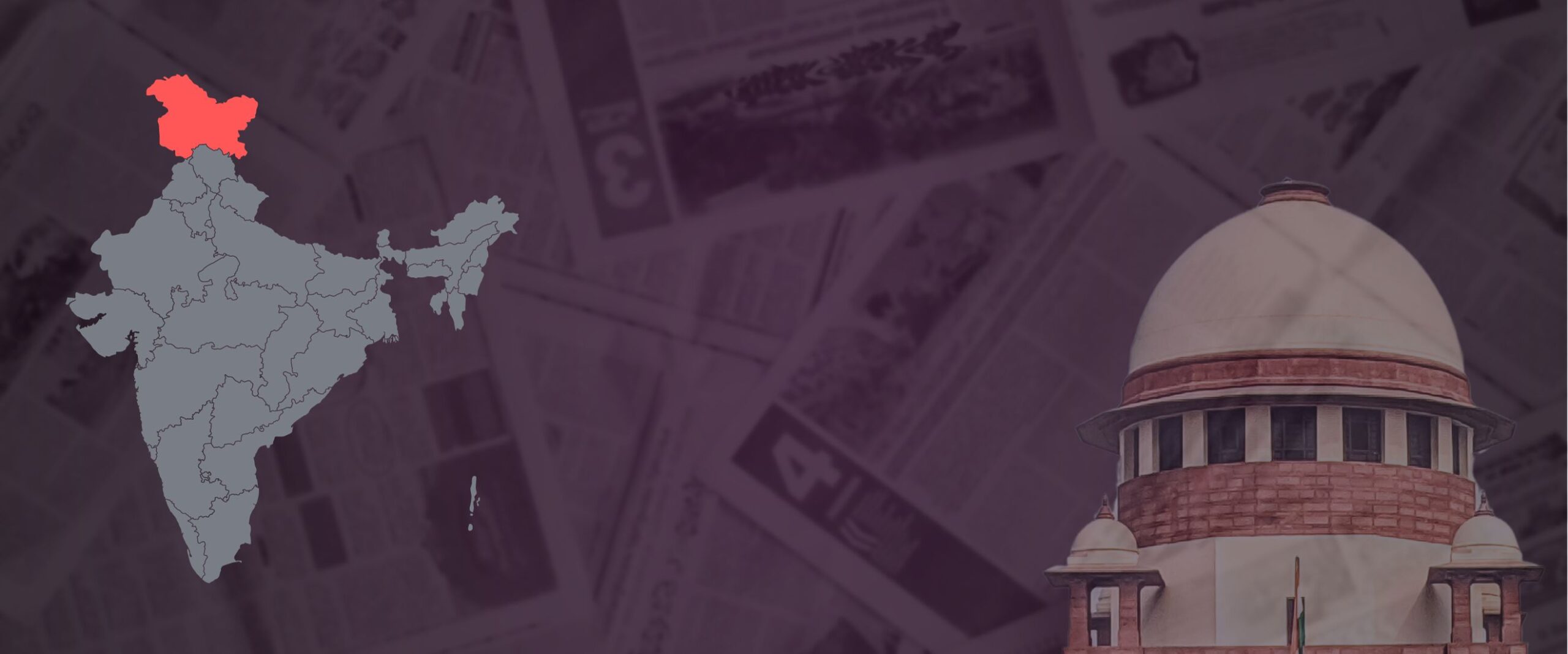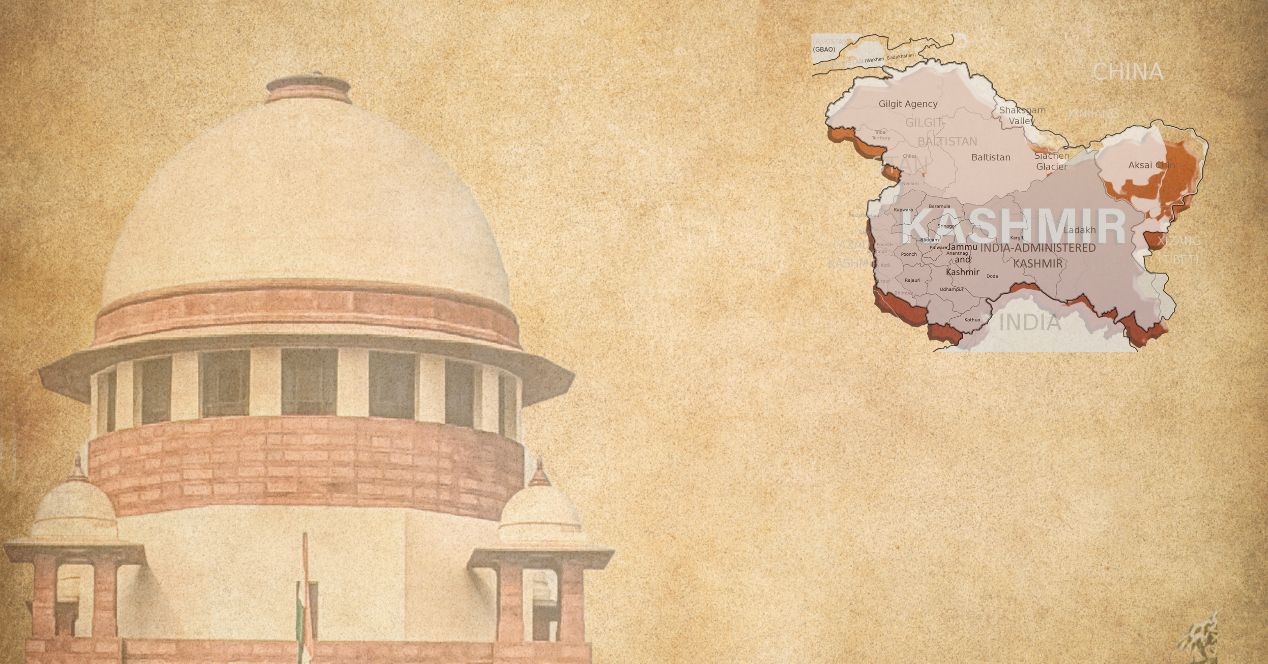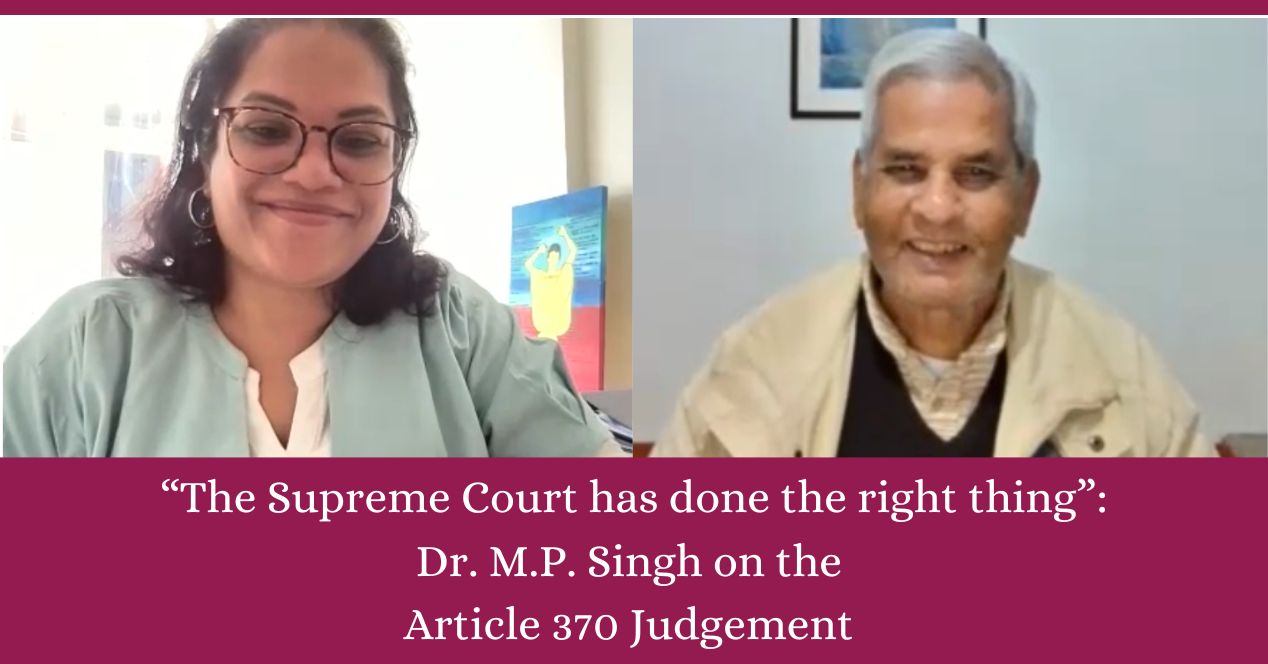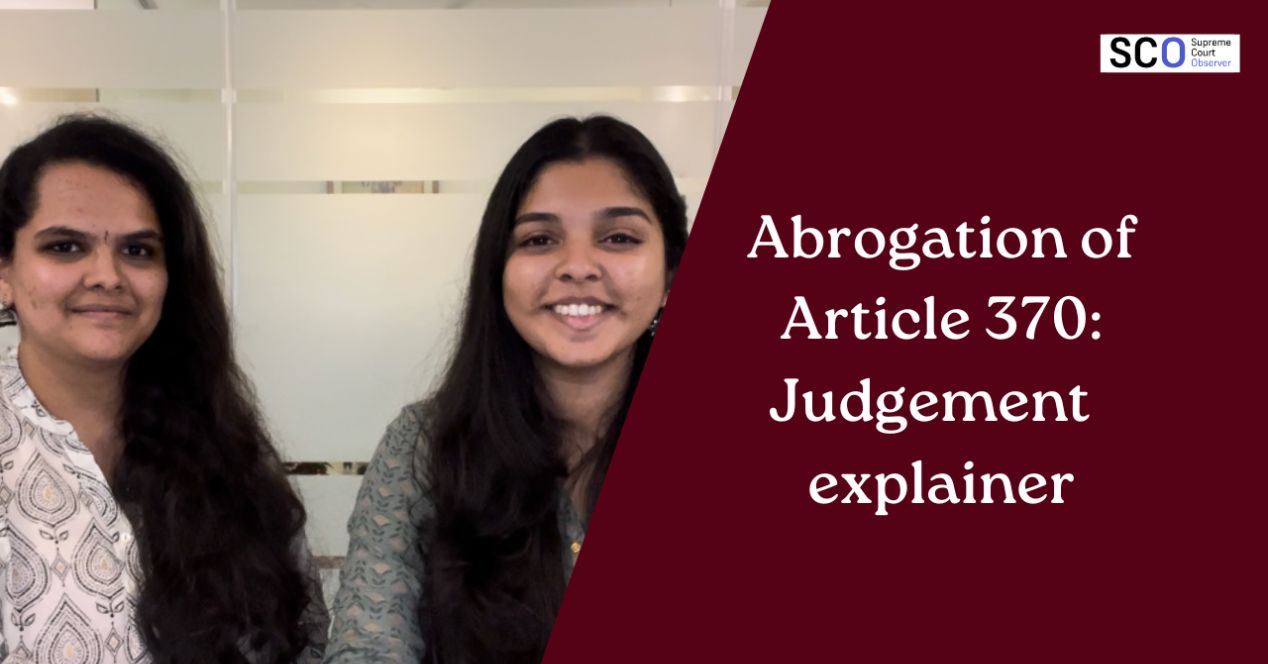Analysis
‘History in service of the present’: The Article 370 judgement and its discontents
Through its skewed historical narrative on Article 370, the Court produces an alternative track for its abrogation

On 11 December 2023, the Supreme Court unanimously upheld the abrogation of Article 370 of the Indian Constitution. The Court heavily relied on history and combined it with a purposive reading of the constitutional text, enabling it to define Article 370 as an instrument of integration. Constitution Orders 272 and 273, therefore, were a natural culmination of this integration.
Even though it was the two COs that were at the heart of the challenge, the majority judgement’s historical narrative produced an alternative track to abrogate Article 370, surpassing even the unilateralism of the Indian government on 5 August 2019. As much as this case is about Article 370, it also raises the question of constitutional courts engaging with history and producing narratives that suit its interpretation of the Constitution. In this essay, I highlight some of the problems with the Court’s historical narrative on Article 370.
Historical promise reduced to ‘benevolent concession’
The majority judgement first holds that the State lost all vestiges of sovereignty after executing the Instrument of Accession (IoA) and the 1949 Proclamation by Yuvraj Karan Singh. For the Court, the 1949 Proclamation, ratified the entirety of the Indian constitution in J&K, and consequently nullified clause 7 of the IoA (which prevented the application of the Indian Constitution to the state), thereby bringing the State on par with the rest of the merged princely states.
This was cemented by the application of Article 1 to the State. Therefore, once a merger with India was achieved, the autonomous character of the State became but a limitation that the Union had imposed on itself. The authority and role of J&K’s Constituent Assembly (JKCA) under Article 370, as per the Court, was defined only to send a “message of goodwill” to the people owing to the special circumstances prevailing in the state.
Turning to the scope of Article 370, the Court combines its reading of the marginal note and textual interpretation of Article 370 to conclude that Article 370 was a temporary and transitional provision by design. Temporary, because of the special circumstances in the State as outlined by N. Gopalaswami Ayyangar in the Indian Constituent Assembly, and transitional, owing to the future convening of the JKCA for defining the Union’s jurisdiction.
Having defined Article 370 as a temporary provision and yet a benevolent concession, the Court turns to Article 370(3) and holds that it provides for ratification of the Indian Constitution like in the case of the rest of the princely states. Therefore, the recommendation of the Constituent Assembly was not binding on the President—its purpose was to only confirm what had already been ratified by the ruler through the 1949 Proclamation.
One of the problems with resorting to history for the purposes of constitutional interpretation, as Saunders and Kennedy (2020) argue, is that “history [is used] in the service of the present.” Both originalists and non-originalists draw on history in response to the controversies of the present moment, to advance a particular reading of the Constitution. What connects the two approaches is the “unwillingness to look at history on its own terms.”
Since constitutions are historical texts, the meaning and intent of the constitution-makers can only be understood by a “rigorous understanding of historical context.” This assumes more significance in a federal framework as the individual states have their own expectations from their relationship with the Union. The Court, being not just the constitutional court for the Union but also for the states, should consider these varied perspectives so that history is not telescoped for the purposes of the present moment.
The Supreme Court relies heavily on history, and if I make a distinction between the sources from Indian and J&K’s constitutional history, the former takes centre stage in the judgement. The Court in any case runs a roughshod over it but here I want to focus on the Court’s treatment of the latter. Because, while it is important to question the conclusions of the Court, it is equally important to question the sources that the Court relies on, how it engages with these sources, and which sources the Court ignores in the process.
The Court rules that sovereignty was lost completely by the state, but what does that imply for the Constituent Assembly of J&K, particularly since the Court admits that the JKCA was vested with constituent powers? The JKCA ratified the state’s accession to India on 6 February 1954 when it adopted the Indian Constitution, therefore the logical conclusion is that the Assembly had competence over the three acceded subjects as well. A body can only ratify something if it possesses the same powers as the entity that initially undertakes the action. The Report of the Drafting Committee stated:
‘The Annexure to this Report [draft of CO 44] while reflecting the desire of the House for the ratification of the accession of the State with the Union of India, indicates in detail provisions of the Constitution of India which generally correspond to Defence, Foreign Affairs and Communication and such other matters as are considered essential concomitants of the fact of accession.’ [Report of the Drafting Committee, J&K Constituent Assembly Debates, Vol I (11 February 1954)]
If sovereignty was lost and the state had merged into India, the Assembly could not have assumed the powers of ratification. Further, it could not have intended to ratify the accession when a merger had already been achieved by the 1949 Proclamation. It’s worth pointing out here that the ratification of accession by the JKCA was relied on by the Indian State to counter the claims of the All J&K Plebiscite Front and others who challenged the validity of the IoA. Therefore, it was imperative for the court to ascertain the powers of the Constituent Assembly, rather than solely imposing limitations on these powers or, worse, reducing them to a mere “message of goodwill.”
Privileging one intent over another
Constitutional interpretation cannot erase the bilateralism involved not only in the processes of Article 370 but in the very making of it. If the text of Article 370 reflects the intent of the Indian Constituent Assembly to integrate J&K, the text also reflects the intent of the state government to preserve its autonomous character. The exchange between Ayyangar and Sheikh Abdullah on Article 370 makes it evident that the J&K government intended to safeguard its autonomy in all matters, except for the three acceded subjects. The Court should have shown on what constitutional principle it privileges one intent over the other, especially in this context since the Indian Constituent Assembly cannot claim authorship of Article 370.
Even for a simple contract, courts rely on the intent of the parties involved. But, in its ruling, the Court has completely brushed aside the state’s own expectations from the constitutional relationship with India. While the Court makes a reference to four speeches from the J&K Constituent Assembly Debates to show that it agreed with its Indian counterpart, it is telling that all the speeches are post-1953 and by people who collaborated with the Indian government in bringing about the dismissal of Sheikh Abdullah. Even in relying on these speeches, the court misreads them to make its point about J&K’s loss of sovereignty.
It is surprising that the speeches of members who negotiated the constitutional relationship with India like Sheikh Abdullah, Mirza Afzal Beg, Justice Shahmiri, a judge in the J&K High Court and the constitutional advisor to the JKCA, have been completely ignored, despite being heavily relied on by the petitioners. For Sheikh Abdullah, for instance, the temporary nature of Article 370 was due to the JKCA’s pending task of defining the constitutional relationship with India. He pointed out:
‘The temporary natures of this Article arise merely from the fact that the power to finalise the constitutional relationship between the State and the Union of India has been specifically vested in the J&K constituent assembly…which would be, finally competent to determine the ultimate position of the State in respect of the sphere of its accession which would be incorporated in the shape of permanent provisions of the Constitution.’ [Sheikh Abdullah, J&K Constituent Assembly Debates, Vol I (11 August 1952)]
Reports of a Constituent Assembly are supposedly more important than speeches for the purpose of constitutional interpretation. The Court relies on the Interim Report of the Basic Principles Committee which recommended the abolition of monarchy but ignores the Committee’s Final Report which became the basis for the CO 44 and the state constitution. This report was categorical:
‘While preserving the internal autonomy of the State all the obligations, which flow from the fact of accession and also its elaborations as contained in the Delhi Agreement should find an appropriate place in the Constitution. The Committee is of the opinion that it is high time that finality in this respect should be reached, and the relationship of the State with the Union should be expressed in clear and precise terms.’ [Report of the Basic Principles Committee, J&K Constituent Assembly Debates, Vol I (3 February 1954)]
This historical material is important not only because it contradicts the Court’s monist and purposive reading of Article 370 as an instrument of integration but also because it shows how and to what extent the aspirations of constitution-makers in J&K differed from the aspirations of the Indian Constituent Assembly.
All of the previous Supreme Court cases on Article 370 have never meaningfully engaged with J&K’s Constituent Assembly Debates or its reports, privileging Indian constitutional history over J&K’s. One wonders which is worse: the previous cases which completely disregarded the J&K Constituent Assembly Debates and reports, or the present case, which selectively references and distorts them.
The 1949 proclamation and lack of merger agreement
Much of the judgement’s superstructure rests on the Court’s reading of the 1949 proclamation as having the effect of nullifying clause 7 of the IoA. The problem lies with the Court overstating the role of this Proclamation and in turn collapsing the trajectory of the India-J&K constitutional relationship completely into the wider integration of the princely states, ignoring vital differences between the two.
In J&K’s Proclamation, the term ‘Constitution of India’ was suffixed by “in so far as it is applicable.” The Proclamation also stated that the Constitution shall “govern the constitutional relationship between this State and the contemplated Union of India” as against the “Constitution of India will be the Constitution for [the said state],” which was the wording in the proclamations for the rest of the princely states.
As Prem Nath Kaul (1959) holds:
‘By this proclamation Yuvaraj Karan Singh purported to make applicable to his State the Constitution of India…in so far as was applicable; in other words, this proclamation did not carry the constitutional position any further than where it stood after and as a result of the execution of the Instrument of Accession by Maharaja Hari Singh.’
Therefore, the Proclamation’s impact is confined to the application of Article 370 to the state and nothing more. It is only to that extent that it could nullify clause 7 of the IoA and override any conflicting constitutional provisions existing in the state then. Much like with its treatment of J&K’s constitutional history, the Court decontextualises the Proclamation and ends up equating it with the Proclamations of the rest of the princely states.
In conclusion, the Court’s simplistic reading of constitutional history, and its skewed historical narrative on Article 370 produces an alternative track to abrogate Article 370. The Court goes so far as to excise the process adopted on 5 August 2019 and imbues the demise of Article 370 with invented meaning and constitutional legitimacy.
Zaid Deva is a lawyer based in Srinagar.




